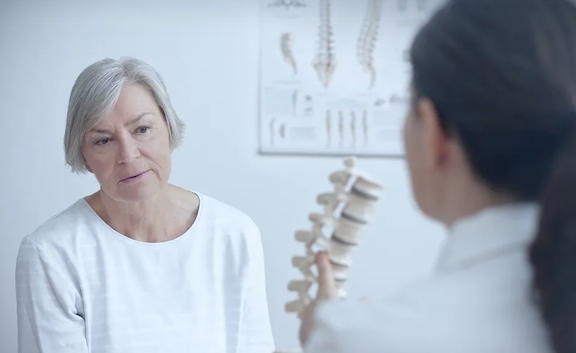Spinal stenosis, especially in the lumbar region, is a very common problem affecting about 11% of older adults in the United States. Furthermore, about 20% of adults over the age of 60 show evidence of spinal stenosis in imaging scans. Fortunately, Chiropractors specialize in all things related to the spine, and although spinal stenosis doesn’t have a definite cure, chiropractic treatment is a non-surgical option that is beneficial.
Spinal Stenosis
Spinal stenosis is when there is a narrowing space in the spinal column, and that narrowing puts pressure on the nerves causing the patient pain. There are two main types of spinal stenosis; lumbar located in the lower back and the most common, and cervical located in the neck. It does not usually heal on its own unless it is being caused by another condition such as a bulging or herniated disc. Since this is the case, treatment is usually necessary to either delay or rectify the condition.
Common Spinal Stenosis Symptoms:
-
Numbness in extremities
-
Difficulty walking
-
Balance problems
-
Neck pain
-
Low back pain
-
Weakness/pain/cramping in the buttocks, legs or feet
While these are the common symptoms, there are many times that spinal stenosis often causes no symptoms at all, but they show over time.
Although there are some people that are born with a small spinal canal, but most often spinal stenosis occurs when a condition or something else causes the open space within the spine to decrease.
Possible Causes of Spinal Stenosis:
-
Herniated Discs – discs being the shock absorbers between the bones of the spine, and when any of the soft material within the disc leaks, it presses on the spinal cord.
-
Thick Ligaments – when the ligaments that hold the bones of the spine together become thick or stiff over time.
-
Bone Spur – damage from arthritis causing extra bone growth on the spine pushing on the spinal canal.
-
Spinal Injuries – this can be from car accidents, back surgery, or other trauma causing swelling in the tissue near the spinal cord. This puts pressure on the spinal cord or nerves.
-
Tumors – although it’s rare, tumors can form within the spinal canal.
There are also conditions that many patients are born with that can cause spinal stenosis.
-
Scoliosis – curved spine
-
Achondroplasia – inherited condition causing an issue with bone formation in the bones of the spine and other bones within the body.
-
Congenital Stenosis – born with a narrow and small spinal canal
In traditional medical care, patients will more than likely have a few options; pain medicine, steroid injections, or for patients with advanced stenosis, surgery. Unfortunately, in the case of advanced stenosis, surgery may be the only option. However, the issue with this is that in the case of spinal stenosis, it can be progressive even after having surgery leaving patients to experience new symptoms after surgery. Since this can be the case, modalities like chiropractic can be a welcomed option to stave off spinal stenosis becoming more severe.
Chiropractic & Spinal Stenosis
Although surgery may be the proper option for some patients, and it is our job as chiropractic providers to advise the patient properly, it is also vital to let patients know to evaluate their options. Chiropractic treatment is an effective, non-invasive, and gentle treatment option that, in the case of spinal stenosis, will relieve pressure and reduce pain in both the neck and back. Chiropractic adjustments will relieve pressure on the nerves, strategic stretching will add a small bit of space releasing pressure temporarily lengthening the spine, and manipulation will offer pain relief.
Types of Spinal Stenosis Chiropractic Treatment:
-
Stretches & exercise
-
Lifestyle advice
-
Manual spinal adjustments
-
Massage therapy
-
Electric stimulation
-
Ultrasound therapy
-
Flexion/extension technique
Patients may have reservations with chiropractic treatment for their spinal stenosis as they may have heard rumors that chiropractic treatment would make it worse. However, it is important to advise them that spinal stenosis is a condition that can be aggravated or even caused by a misalignment in the neck or spine. Getting chiropractic adjustments and manipulations can relieve stress on the nerves in the spinal column. Additionally, we should educate patients on the effects of poor posture on spinal stenosis, potentially causing more pain in their spinal stenosis.
Additionally, patients should know, that as of present, spinal stenosis cannot be cured, only managed. When comparing traditional care with chiropractic care, the main benefit to chiropractic over traditional care is that it treats down to the root issue, not just symptoms.
-
Traditional treatment – provides symptomatic relief using pain medications to reduce pain, and surgery to aid in pain if the spinal stenosis is more advanced. However, this type of care does not always decrease the pressure that is being put on the spine and nervous system, nor does it prevent progression of the spinal stenosis.
-
Chiropractic treatment – provides symptomatic relief as well, but without the side effects of medications or risk of surgery. Also, different chiropractic techniques can open the space in the spinal canal relieving the pressure within the discs while restoring motion by realigning the joints. The flexion-distraction technique is great to use for spinal stenosis patients. In fact, a study completed in October 2022 found that the use of the flexion-distraction technique for spinal stenosis showed significant improvement in lumbar spinal stenosis patients.
Benefit of Chiropractic for Spinal Stenosis

